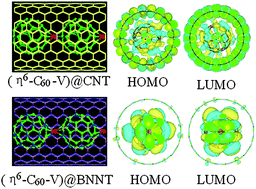Carbon nanotube and boron nitride nanotube hosted C60–V nanopeapods†
Abstract
We investigate electronic and transport properties of a novel form of nanopeapod structure, where the “pod” component is either a carbon nanotube (CNT) or a boron-nitride nanotube (BNNT) while the “pea” component is a chain of C60–V dimers. Compared to the conventional carbon peapod where the “pea” is a chain of C60 fullerenes, marked changes in the electronic structures are found due to the formation of coordination bonds between V and two neighboring C60 molecules. The local spins in the (η6-C60–V)@CNT or (η6-C60–V)@BNNT peapod are coupled via antiferromagnetic (AFM) exchange interaction. In particular, the C60–V chain in BNNT yields a well-defined spin qubit. Density-functional theory calculation suggests that the (η6-C60–V)@CNT peapod is metallic with characteristics of multiple carriers contributed from CNTs, C60, and V. The (η6-C60–V)@BNNT peapod is predicted to be semiconducting with a narrow band gap, and its charge carriers are contributed by the C60–V chain. Evidently, the insertion of a V atom between every two C60 fullerenes can enhance the conductivity of the peapod. Binding H atoms on all the α positions of the pentagons in C60 can further strengthen the V–C60 interaction. Both AFM and FM states of the H-containing peapod are nearly degenerate in energy. The FM state gives rise to a magnetic moment of 3.0 μB per unit cell, three times greater than that of the V–benzene or V–cyclopentadiene multidecker complexes. The binding of H atoms to the C60 however cannot enhance electron transport due to the removal of the π channel of C60. Previous experiments have demonstrated that C60 molecules can enter BNNTs through the open tips of the BNNTs, offering a strategy that the V–C60 dimers may be encapsulated into nanotubes through the open tips of the nanotubes to form M–C60 peapods.

- This article is part of the themed collection: 2013 Journal of Materials Chemistry C Hot Papers

 Please wait while we load your content...
Please wait while we load your content...